HINGE DOOR LOCKS
Hinge door locks come in many different types but the two most common are cylindrical type (round hole drilled into the face of a door) and the mortice type (chiseled/drilled into the edge of the door) all with their own unique options. We will cover the main ones found in most homes which can be found in both wooden or aluminum joinery plus some info on commercial ones and a couple common ones used mainly on wooden doors. For Flush Bolts please ref to bi-fold or hinge doors.
Knob Sets or Entrance Handle Sets
Exterior Doors; Entrance Handle Sets or Knob Sets come in a number of different shapes but follow the same basic setup with a key in the middle of the knob on the outside and a push button or turn button in the middle of the knob on the inside. The knob handle when turned pulls the retractable tongue of the lock on the edge of the door back so you can open the door when released the tongue pops back out again. These locks work by pushing in the button or turning the button on the inside going out and closing the door and it’s locked.

The Lever Handle entrance lock instead of a knob is very common. We can change a knob set over to a lever handle it still has a key in the middle of the outside handle and a push button on the inside but rather than a knob to hold onto you get a lever handle which is great for arthritic or elderly people who have trouble turning a knob handle.

Interior Doors have similar looking locks without the key option:
The standard internal one is called a Passage Lock it has no locking/privacy system in it at all only the latch tongue that keeps the door closed.
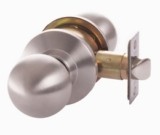
For bathroom toilet situations there’s the Privacy Lock they have a privacy button on the inside and a emergency release hole/slot in the middle of the outside knob/lever.
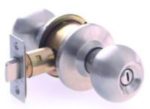
For the wardrobe you can use a passage set but usually with two doors they have a Dummy Handle on each door with spring loaded ball catch in the top of each door panel to keep them closed.
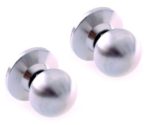
All these exterior and interior cylindrical type locks can come in different backset sizes the backset is the measurement from the edge of the door to the centre of the handle in this type they come in 60mm, 70mm, 95mm and 127mm.
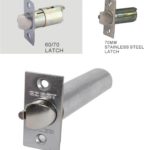
The humble common aluminium back door; the lock is often a push button 127mm backset entrance lock in the centre rail of the door (we carry replacements in the van – For Pricing Please Click Here:). These doors sometimes have a cat door in the bottom glass and there is often a small window that is above the laundry tub next to the door. This lock setup works fine to stop the door from blowing open from the wind however from a security point of view it has three problems:
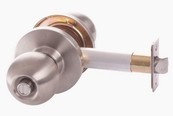
Fitting a Patio Bolt to the inside of this door, some people fit one top and bottom, solves all three of these problems unless of course you use this door to come and go by in which case you can’t access the patio bolt from the outside.
To solve this problem you have three options:
1) Replace the existing key and push button lock with a keyed both sides lock. This lock has a key instead of a push button on the inside which means it opens and closes as per normal but each time you wish to lock or unlock the door you need a key. The retractable beveled tongue on these locks is about 12mm.

2) Replace the existing lock with a retro fit Lever Handle Double Throw Horizontal Mortice Lock now that’s a mouth full. This lock is designed for this problem the lever handle acts as per a normal open and close latching lock however put the key in and turn it twice and it throws the short 12mm latching tongue out to make it a 25mm deadbolt. This lock goes inside the centre rail of the door replacing the existing lock.

3) Leave the existing lock and fit a commercial type key operated deadbolt into the vertical stile above the existing lock, the only catch with this is if your vertical stile is deep enough to take this lock if it is then in our opinion this is a very secure option and great value for money.
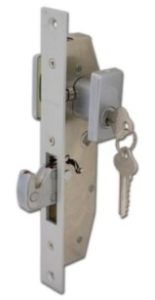
Tubular lock Set (and decorative grip sets)
Tubular lock Set (and decorative grip sets)
For all intents and purposes these are the same as the entrance handle sets above they have a different internal setup and some have external screws showing on the inside to hold the outside and inside handles together because of this screw together difference they also come in the decorative grip set option this is the entrance lock with the big D-handle and push thumb button on the outside of your main entrance door and either lever or knob on the inside normally with a deadbolt fitted above.
Internal doors have similar looking locks without the key option and for bathroom toilet situations they have a privacy button on the inside and an emergency release hole in the front. So the standard internal one is called a passage set and the bathroom toilet one is called a privacy set with just the knob for a wardrobe called a dummy set.

Lever Lock Sets
Lever Lock Sets
2 – Point: Second one has the retractable tongue plus either a drop down bolt (long throw) or push out bolt (short and long throw) this makes it a 2-point lockset.
4 – Point: Third one has the retractable tongue plus either a drop down bolt (long throw) or push out bolt (short throw) as well as locking rod/bolts running inside the stile going out the top of the door and bottom of the door. This is called you guessed it a 4-point lockset.
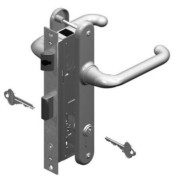

Deadbolts
Deadbolts


Aluminium Doors; The most common deadbolts for aluminium doors are the lever lock sets.( two of these where mentioned above under lever lock sets)

Lever Handle 4 – Point: has the retractable tongue plus either a drop down bolt (long throw) or push out bolt (short throw) with the drop down or push out bolt being the deadbolt part as well as locking rod/bolts running inside the stile going out the top of the door and bottom of the door. This is called you guessed it a 4-point lockset.
These locks can come in different backset sizes the backset is the measurement from the edge of the door to the centre of the handle or key hole in this type of lock there is a narrow backset found in older doors 25mm then newer doors they go 30mm, 40mm and 50mm.

Replacement fit Double Throw Deadbolt; for aluminium door with a push button lock in the centre rail is called a Lever Handle Double Throw Horizontal Mortice Lock now that’s a mouth full. This lock is designed for this problem the lever handle acts as per a normal open and close latching lock set, however put the key in and turn it twice and it throws the short 12mm latching tongue out to make it a 25mm deadbolt. This lock goes inside the centre rail of the door replacing the existing lock. (Listed above under knob sets.)
Deadbolt 23mm short backset: Leave the existing lock in the door and fit a commercial type key operated deadbolt into the vertical stile above the existing lock. The only catch with this is if your vertical stile is deep enough to take this lock if it is then in our opinion this is a very secure option and great value for money for securing an existing aluminium door. (Listed above under knob sets.)

Door Viewers
Door Viewers
Door viewers are a small spy glass that lets you see who is on the other side of a door before you open it. The viewer is installed at eye height in the middle of the door.
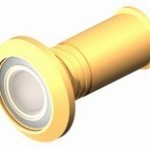
Digital Locks Mechanical
Digital Locks Mechanical
This type of lock has a mechanical key pad on the outside with a knob beneath it once the right code is punched in you turn the knob which pulls the retractable tongue back and you can open the door. Normally it has a lever handle on the inside which you just pull down to open the door. The combination is changeable.
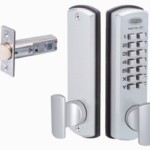
The other option is the touch screen that comes with a whole lot of options.
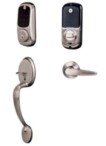
Patio Bolts
Patio Bolts
Patio bolts can be fixed to the inside of hinge doors both timber and aluminium normally at the top with the bolt going firmly into the door sill some people put a second one on at the bottom of the door especially on light framed aluminium panels.
Wooden Door Locks
Wooden Door Locks
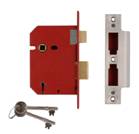

Locks Jamming
Locks Jamming

OFFICE LINE
(07) 543 3766
MOBILE / EMERGENCY
027 600 3357
WORKING HOURS
8:00am – 5:00pm
OFFICE LINE
(07) 543 3766
MOBILE / EMERGENCY
027 600 3357
WORKING HOURS
8:00am – 5:00pm
BOOK A JOB
Do you need help with a window, lock or bumpy sliding door? Fill out this form to get in touch.

